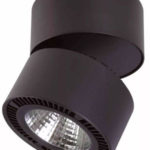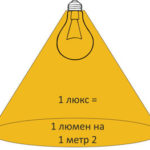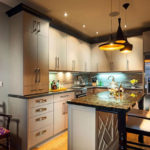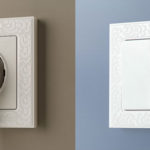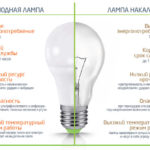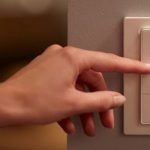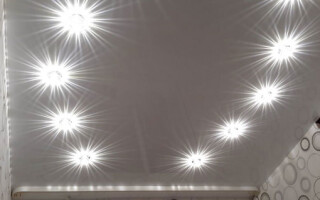Today the stretch ceiling is the most common variant of finishing the ceiling. It allows you not only to make an even and aesthetic surface, but also to organize high-quality and effective lighting, thanks to the presence of a large number of options for lighting fixtures, each of which has varying degrees of influence on the final cost of finishing the ceiling. In this article, we will consider spotlights, the rules and options for their placement on the suspended ceiling.
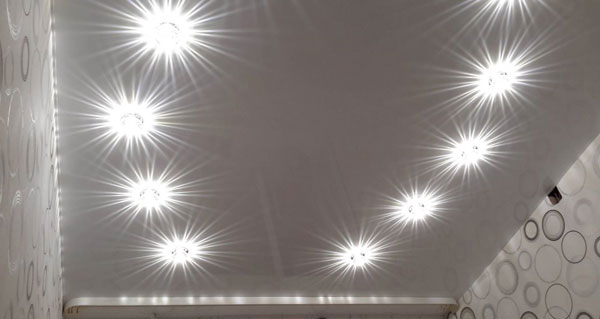
Contents
Schemes and options for the location of point light fixtures on the suspended ceiling depending on the room
The location and number of spotlights depends on several factors:
- the purpose of the room: For example, the kitchen may need brighter lighting, especially near the work area, but the bedroom may need softer and more comfortable lighting;
- lamp wattage: More powerful fixtures cover a larger area and, therefore, fewer are needed;
- number of zones: room lighting can be divided into zones (decorative lighting, lighting above the bed) or by the purpose of the light (night, bright, decorative).
In any case, an important factor to focus on is your own preferences. But some of the recommendations below will help to navigate and understand the intricacies of lighting in each room.
The most common typical layouts of lighting fixtures for different rooms are shown in the pictures below.
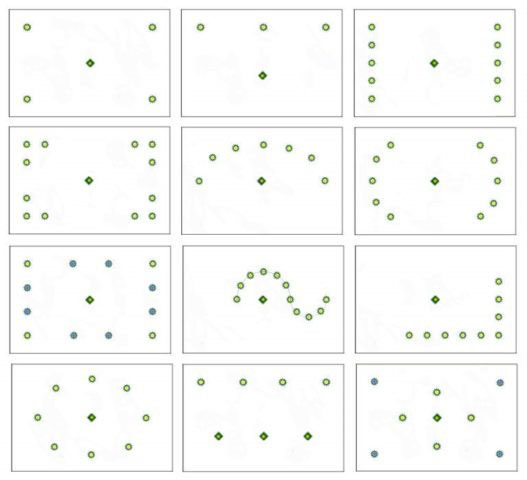

For the bedroom
Bedroom is an area of sleep and rest, so, usually, here you do not need bright lighting and a large number of lamps. Most often in modern interiors use multi-level ceilings with a division of lighting zones into soft and basic. There are many options and layouts, the most common: in the form of an oval or square around the perimeter of the bed for basic lighting, as well as corner lights for evening lighting.
There may not be a division into zones, as non-powered fixtures or dimmers can be used to adjust the brightness of the light depending on the current need.
The normal, when using LED spotlights in a bedroom, is to meet the condition of 2 W/m2. But if the room already has sconces, floor lamps or other lighting devices, this rate can be reduced.
For the living room
The living room is the largest room in the house, designed for gathering, relaxing and entertaining, and therefore requires good and bright lighting. In this room, spotlights can be placed in conjunction with a chandelier, as additional lighting, or as the main living room lighting.
When thinking about the layout of lighting fixtures in the living room, it is important not to forget about the fact that for comfortable viewing of home theater or television, it is necessary to separate the room into a dark and lighted zone.
In general, the norm power LED lights for this room 3 W/m2but, of course, the final decision on the power of lighting fixtures should be taken on the basis of your own wishes, shape and number of levels of suspended ceiling.
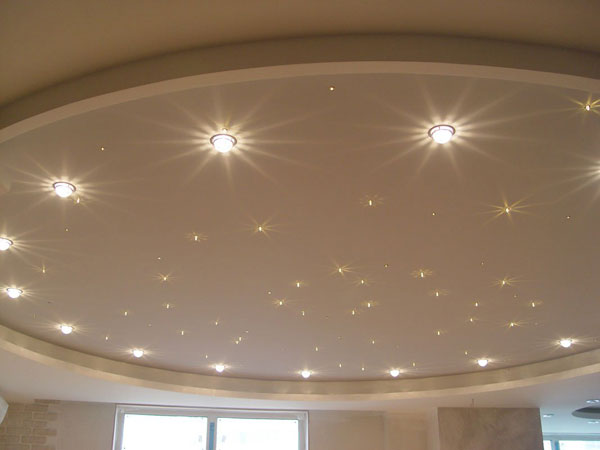
For children's room
A child's room should have enough light so the child can play, do homework or do other activities without the risk of damaging his or her eyesight. So here you should not skimp on the number and quality of lighting fixtures.
The children's room can be divided into areas with soft lighting above the bed and bright lighting above the area where the child will be studying, playing or learning.
The norm of lighting with LED spotlights is in the range of 5 to 8 watts per square meter for a child's room.
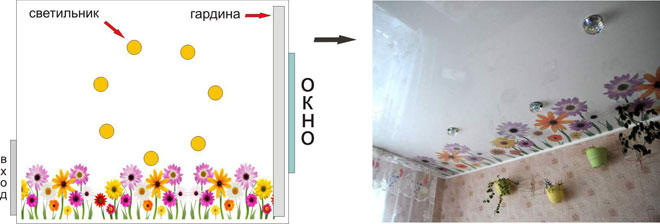
In the kitchen
The kitchen is often combined with the dining room, so here, too, you can zoned lighting. Lights can be placed over the dining table and kitchen work area, or you can make general lighting by placing spotlights in a square or oval that will cover all areas at once.
When planning lighting in the kitchen, it is important to properly consider the placement of fixtures so that they are not above kitchen cabinets and other elements of the set, which will overlap the lighting fixtures.
For the kitchen, spotlights should be chosen on the basis of 4 watts per square meter. If there is a chandelier, the number of fixtures or their power can be reduced.
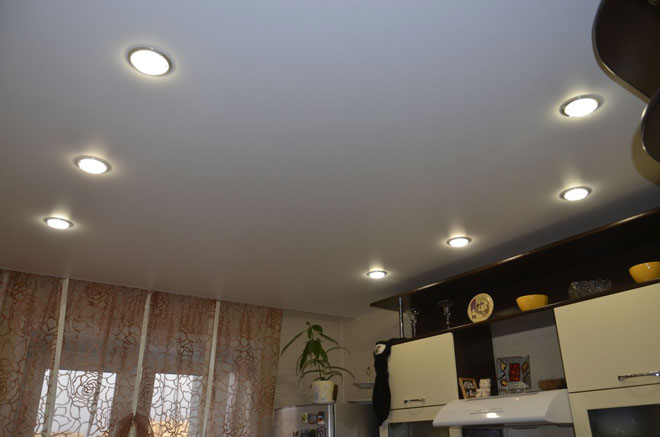
In the bathroom
The number and power of lights in the bathroom depends on the layout. In combined bathrooms you need more of them, unlike a separate bathroom. But in general, the basic rule for placing spotlights in the bathroom stretch ceiling is as follows: lamps should be placed over the bathroom, washbasin, in places where there is a mirror.
When organizing lighting in the bathroom, you can use the general arrangement of spot lamps. Calculation of the number of this method is based on the norm for LED lamps for this type of room: at least 2 W/m2. Of course, the brighter the lighting, the more convenient it will be for women to apply makeup, for men to shave, and for the whole family to wash in the bathroom.
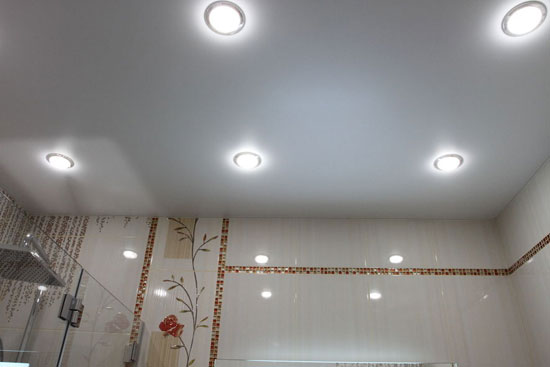
Do not forget about the evening/night lighting. Sometimes you need to visit the bathroom at night, and bright lighting can cause discomfort. That's why it's a good idea to think in advance about an area for evening lighting and a separate switch for it.
In corridors and hallways
Usually hallways in residential apartments are narrow and elongated rooms, so the lights in the stretch ceilings are placed in one (sometimes two) extended line. The number of spotlights depends on the length of this room, with LED power points should be at least 1 watt per square meter.
In the hallway also often have mirrors, so it is best to use bright lamps or place them more often for convenience.
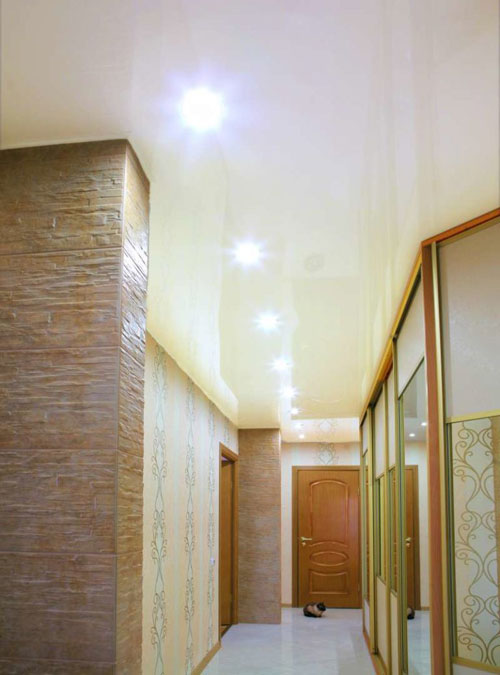
Useful tips on the placement of light fixtures
Of course, the placement of fixtures and the brightness of lighting in each room depends largely on the owner and user of the room. But in order not to make a mistake and to organize the correct and effective lighting, you can follow some important tips:
- The minimum distance when placing spotlights on a suspended ceiling: from the edge of the fixture to the wall at least 20 cm (for good light diffusion), from lamp to lamp at least 30 cm (depending on the wattage of the lamps), and from the seam of the ceiling at least 15 cm;
- When the chandelier and points are placed together on the ceiling, spotlights are placed along the perimeter of the room in the least illuminated places;
- When installing more than 20 points, it is worth thinking about the grouping and separate power supply for each group. For example, you can combine the lamps in the evening lighting in one group, and the main in another;
- When designing lighting, you should be guided by the type of room, zoning, the purpose of lighting and the minimum value of lighting standards for this type of room;
- When using a glossy stretch ceiling, the power of the lamps or their number can be reduced, because such a ceiling allows you to visually increase the room and increase the brightness of the lamps;
- It is also worth focusing on the fact that one point of light is able to illuminate a space of about 1.5 square meters around itself;
- The most effective use of Energy-saving LED spotlights for stretch ceilings: they warm up less and illuminate space very effectively, while having the lowest power consumption.

